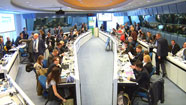On 5 April 2016 the JRC presented the interactive and collaborative online European Energy Efficiency Platform. This beta platform is conceived to fill the gap opened by scattered data and fragmented knowledge resulting from a rapidly growing energy efficiency market. It is expected to be both a one-stop shop for information retrieval and a meeting point for experts to exchange data and reduce redundant activities.
Pilot project on energy and location

Introduction
This section is dedicated to news and activities within the pilot project on energy and location, jointly carried out by the EC DG JRC project on Energy and Location and the European Union Location Framework (EULF) action of the EC Programme Interoperability Solutions for Public Administration (ISA).
A feasibility study “Location Data for buildings Related Energy Efficiency Policies” was concluded in 2015. It confirmed an approach to support the data monitoring requirements of the Energy Performance and Buildings Directive (EPBD), the Energy Efficiency Directive (EED) and the Covenant of Mayors (CoM) initiative, based on the re-use of INSPIRE components. The study made an initial analysis of the data flows relevant to EPBD, EED and CoM, identified relevant INSPIRE data themes, and carried out an initial mapping exercise. Because of the variations in available data and the need to link data at different administrative levels, there is a need to properly combine data of different nature (e.g. calculated vs. measured, static vs. dynamic). As these policies are linked to energy savings actions, validation and interaction with building owners and industry is important in the overall methodology.
The energy and location pilot
A pilot project is now being mobilised, with an initial kick-off workshop held in Ispra from 24-26 November 2015 with participants from BE, DE, DK, ES, EL, IT, SE, TU and UK. The pilot will involve a series of cities and regions to demonstrate how an integrated data approach can be established for planning, implementation, monitoring and reporting for the multiple policies and initiatives, considering energy performance of buildings, energy consumption of buildings and energy production at a local level. This will be done through:
- adoption of common structured data models (extending some INSPIRE core data models)
- use of common data access mechanisms (INSPIRE Network Services)
- re-use of (parts of) datasets for different planning, implementation, monitoring and reporting purposes
- data access agreements to use the relevant data
- development and application of relevant methodologies and models to fill data gaps
- use of both centralised and distributed ICT infrastructures which make accessible the data needed to fulfil planning, implementation, monitoring and reporting requirements
By the end of 2016, the initial phase of the pilot will be implemented and tested through a series of use cases, involving different stakeholders (public authorities at local and regional level), businesses working in the energy sector and citizens (building owners).
Use cases
Six use cases have been designed, based on the feasibility study and integrating stakeholder views. They will be developed and implemented in the course of the project.
Use Case 1 – INSPIRE Harmonization of existing Energy Performance Certificate datasets and creation of a web application for accessing them
Use Case 2 – Implementing different buildings' Energy Performance Labelling, including crowd sourcing data
Use Case 3 - Energy Performance of buildings with dynamic measured data
Use Case 4 - To support buildings' energy efficiency driven refurbishment planning at local level
Use Case 5 – To support integrated energy planning and monitoring at urban/local level (SEAP BEI/MEI)
Use Case 6 – Support the design and implementation of a regional energy strategy





To quote this article use the follonwing format: